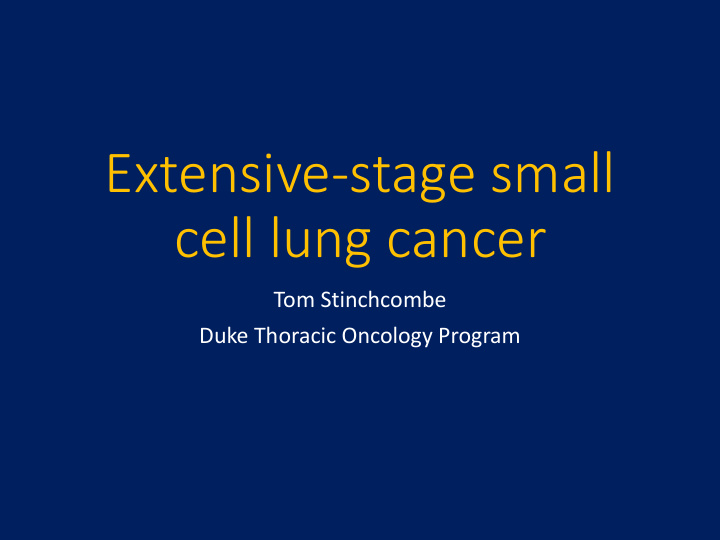



Extensive-stage small cell lung cancer Tom Stinchcombe Duke Thoracic Oncology Program
Extensive stage (ES) small cell lung cancer • Patient with SCLC who presented with extensive-stage disease and received carboplatin and etoposide as first-line therapy • PCI completed • Progressive disease 2 months after completing chemotherapy • Treated with thoracic radiation for symptomatic disease • Nivolumab x 4 cycles with progressive disease • Topotecan daily x 5 days for 2 cycles with progressive disease • Enrolled in phase 2 trial of rovalpituzumab tesirine (Rova-T)
Small cell lung cancer on clinical trial of Rova-T Baseline Confirmatory scan
Extensive-stage small cell lung cancer Tom Stinchcombe Duke Thoracic Oncology Program
PCI in ED-SCLC: EORTC 08993-22993 R PCI A No response 20-30 Gy in N Chemotherapy 5-12 fractions D (4-6 cycles) O Any response M Stratify by: I No PCI • Institution Z • PS E n=286 < 5 weeks 4-6 weeks Primary endpoint: time to symptomatic brain metastases defined as signs of increased intracranial pressure, headache, nausea and vomiting, cognitive or affective disturbances, seizures, and focal neurologic symptoms Secondary end-points : OS, Qol, toxicity, cost Slotman et al. NEJM 2007.
Ov Overall su surviv vival: al: me measu sured from om randomizati rando ation 100 90 1 year: 27.1% vs. 13.3% 80 70 HR: 0.68 (0.52-0.88); p = 0.003 60 50 40 30 PCI 20 Control 10 0 (months) 0 4 8 12 16 20 24 28 32 36 Slotman et al. NEJM 2007.
PCI in SCLC: Trial Design No response PCI: 25 Gy 1 st line chemo 10 fractions • Any response • No BM by MRI Platinum-based R assessment doublet no PCI < 6 weeks Stratification by Age (<70 / ≥70), n=163 3-8 weeks PS (0-1 / 2) Response (CR / PR+MR) Follow-up by MRI imaging Institutions evaluated every 3 months Primary endpoint: Overall Survival Secondary endpoints: Time to brain metastases (BM), Progression-Free Survival (PFS), Safety, Mini Mental State Examination (MMSE) ASCO 2014 Abstract 7503: Presented by Takashi Seto
Overall Survival Arm A: PCI Arm B: no PCI n=84 n=79 No. of OS Events 61 50 100 Hazard ratio (95%CI) 1.38 (0.95-2.02) 90 Median OS (95%CI), mo 10.1 (8.5-13.2) 15.1 (10.2-18.7) 80 70 60 Arm A: PCI 50 Arm B: No PCI 40 30 20 10 Stratified log-rank test: P=0.091 (2-sided) 0 0 3 6 9 12 15 18 21 24 27 30 33 36 39 ASCO 2014 Abstract 7503: Presented by Takashi Seto
Trials of immunotherapy in SCLC ORR Duration of Treatment Patient population (95% CI) response Nivolumab 3 mg/kg Unselected 10% Not reached (n=98) (5-18) (4.4 to NR) Nivolumab 3 mg/kg Unselected 19% 4.4 Ipilimuab 1 mg/kg (n=54) (9-31) (3.7 –NR) Nivolumab 1 mg/kg Unselected 23% 7.7 Ipilimumab 3 mg/kg (n=61) (13-36) (4.0-NR) Pembrolizumab PD-L1 ≥ 1%* 33% 19.4 10 mg/kg (n=24) (15.6-55.3) (3.6+ to 20.0+) * 147 evaluable samples and 42 PD-L1 positive (28.6%) Antonia et al. Lancet Oncology 2016; Ott et al. WCLC 2016.
Phase 2 trial of nivolumab alone and with ipilimumab Progression-free survival Overall Survival Median OS Median PFS Nivolumab : 4.4 months Nivolumab: 1.4 months Nivolumab 3/Ipilimumab 1: 6.0 months Nivolumab 3/ Ipilimumab 1: 1.4 months Nivolumab 1/ Ipilimumab 3: 7.7 months Nivolumab 1/ Ipilimumab 3: 2.6 months Antonia et al. Lancet Oncology 2016.
Phase 2 trial of pembrolizumab Progression-free survival Overall survival Ott et al. WCLC 2016.
Rova-T • Delta-like protein 3 (DLL-3), receptor that inhibits Notch signaling • Over-expressed on SCLC and high grade neuroendocrine carcinomas with limited expression on other tissues • Rova-T is DLL-3 antibody drug conjugate with DNA cross-linking agent • Phase 1 trial: 74 patients with SCLC, 39 with 1 previous line (53%) and 35 with 2 previous lines (47%) • Schedule for phase 2 trials: 0.3 mg/kg every 6 weeks for 2 doses • Treatment related grade 3 adverse events: low platelets (11%), pleural effusions (8%), increased lipase (7%) Rudin et al. Lancet Oncology 2016.
Rovalpituzumab Tesirine (Rova-T Ô , SC16LD6.5) Rudin CM et al. Proc ASCO 2016;Abstract LBA8505.
Efficacy of Rova-T Swimmer’s plot Objective response rate DLL-3 ≥ 50% DLL-3 0-49% (n=6): 0% Duration of response: 4.6 months DLL-3 ≥ 50% (n=26): 31% Progression-free survival: 4.6 months Rudin et al. Lancet Oncology 2016.
Adverse Events Associated with Rova-T Adverse event (n = 74) Grade 1-2 Grade ≥3 Thrombocytopenia 4 (5%) 8 (11%) Pleural effusion 17 (23%) 6 (8%) Increased lipase 1 (1%) 5 (7%) Fatigue 23 (31%) 3 (4%) Peripheral edema 18 (24%) 2 (3%) Pericardial effusion 7 (9%) 2 (3%) Acute kidney injury 0 (0%) 1 (1%) Rudin et al. Lancet Oncology 2016.
Sample of ongoing trials in ES-SCLC Primary Disease setting Comparison Phase NCT trial # end-point Platinum/etoposide +/- First line 2 02580994 PFS pembrolizumab Carboplatin/etoposide +/- First line 3 02763579 OS and PFS atezolizumab Cisplatin/etoposide + Rova-T in DLL-3 First line 1 0281999 Safety positive 2 Maintenance Pembrolizumab 02359018 PFS (single arm) Nivolumab, nivolumab/ipilimumab or Maintenance 3 02538666 OS and PFS placebo Second line Nivolumab vs topotecan or amrubicin 3 02481830 OS Second line Pembrolizumab vs topotecan 2 02963090 PFS 3 arm: Rova-T+nivolumab, Second line Rova-T+ipilimumab 1/2 03026166 Safety Rova-T+ nivolumab/ipilimumab
Take-home points • PCI is an option in ES-SCLC but I personally rarely use it and only in carefully selected patients • Preliminary results of immunotherapy trials reveal low response rates but durable responses • Role of single agent immunotherapy, combination immunotherapy, and chemotherapy-immunotherapy combinations will be defined by current trials • Current NCCN recommendation 2A for immunotherapy for patients with progression ≤ 6 months from primary therapy • Rova-T has single agent activity, and is being investigated in a phase 2 trial as 3 rd line therapy. Future development most likely a part of combination therapy https://www.nccn.org/professionals/physician_gls/pdf/sclc.pdf
Extensive-stage small cell lung cancer Tom Stinchcombe Duke Thoracic Oncology Program
Recommend
More recommend